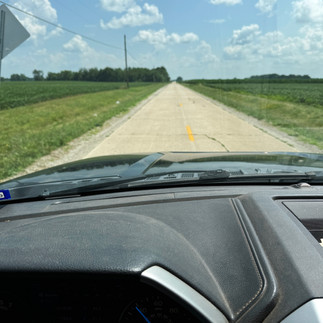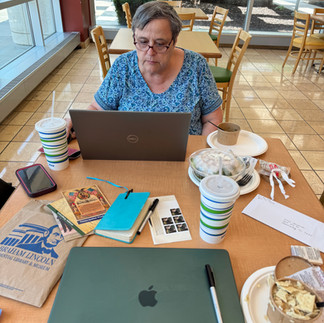Route 66 in the Land of Lincoln
- Barbara Brannon
- Aug 15, 2024
- 3 min read
Updated: Sep 19, 2024
ROUTE 66 RAMBLE, PART 2
“Route 66 has fueled America’s imagination, popular culture, and passion for the open road for nearly a century. It deserves a place not just in our rearview mirror, but on our roadmap of unique travel experiences for generations to come.” — Stephanie Meeks, former president and CEO of the National Trust for Historic Preservation
“The Road Ahead” is the title of the preservation partnership that has worked since 2018 to designate Route 66 a National Historic Trail, under the leadership of Bill Thomas in Atlanta, Illinois. We leave his town in a pouring rainstorm after a brief but enjoyable visit, continuing toward California in the only state where the westward-inclined Mother Road runs north-south.
“I’m confident Rt. 66 will become our country’s newest National Historic Trail soon, and look forward to continuing to work to achieve that goal,” Thomas wrote in the organization’s latest quarterly report, posted shortly before I’d met with him. Representatives in the eight Route 66 states signed onto a House bill to that effect, which was reintroduced in June 2023. But while Congress has taken important steps, legislation also remains to be passed by the U.S. Senate and signed by the president.
In 2022, U.S. senators Ted Cruz (R-TX) and others introduced a companion Senate bill. It’s still sitting in committee, with the 2026 anniversary of The Mother Road fast approaching.
As we drive as much of the original road (“alignment,” in highway terms) as still exists, we can readily appreciate the enormous economic benefit that communities of all sizes realize from the throngs who drive some portion of it annually. Even a dozen years ago the pioneering Rutgers study conservatively estimated the total U.S. impact at $38 million.
But divisiveness and stalemates are nothing new in our federal government, as current events show, and as we appreciated even more profoundly in our visit to one route 66 site: the Abraham Lincoln Presidential Museum and Library in Springfield, capital of Illinois.
The conundrums our 16th president faced over state’s rights versus federal authority during his first election campaign are clarified through documents (approximately 12 million of them, dating as far back as the 18th century, with a small selection of facsimilies on display in the library’s entry lobby) and interpretive exhibits (enough to easily fill half a day’s visit to the museum).
The story of Lincoln’s rise from an “undistinguished” family and humble roots to a skilled militiaman, self-educated lawyer, and devoted family man—and ultimately to the White House—is presented in a variety of clever exhibits. The interpretation of his political career, the U.S. amid civil war, and his assassination and aftermath, richly augmented our learning. From lifelike dioramas to reproductions of images and letters, to a Holovision theater experience, to a walk-through reproduction of the White House of the 1860s, each aspect of Lincoln’s life and career are brought into context. Forensics students looking to understand the premise of a current-day Lincoln-Douglas Debate, researchers grappling to understand the evolving front—and rising casualties—of the War Between the States, or cultural historians interested in the fashions of the day might all find fresh insights.
But most telling, to me, were the reproductions of political screeds and cartoons of Lincoln’s time. Scores of these are skewed in off-kilter frames, hung in exhibit spaces of wildly distorted walls and doors, to echo the cant of critics’ biting words and images.
By comparison, today’s news media come off as polite as greeting cards. More akin to the 19th-century voices depicted here is the 21st-century’s social media space, or its often obscene flags and bumper stickers. I mused on these matters as I wondered whether history is, as claimed, doomed to repeat itself.
But the Lincoln museum has a lot to teach with regard to hope for a strong American union. Once reunited during an arduous Reconstruction, as the exhibits also cover, the states proved resilient and, at intervals, forward-thinking. A temporary exhibit highlighted more recent struggles for civil rights—reminding us clearly that the work is far from over.
I composed last week’s essay in that powerfully evocative space, inspired by words and acts of greatness. As we hit the road again that afternoon, I was ready to appreciate, afresh, a pavement that once knit together a growing number of states, some acquired by arm-twisting deals, some as new as Oklahoma and Arizona (which didn’t become a part of the Union until 1907 and 1912 respectively), one (Texas) that had even been a sovereign nation.
Historic preservation, economic benefit, and open-road vacations are all great reasons to appreciate the treasure that is Route 66. But so are the lessons it can teach us about what it means to be American.
FLICKR PHOTO ALBUMS FOR THIS POST
Route 66 Ramble, Illinois part 2




























Comments